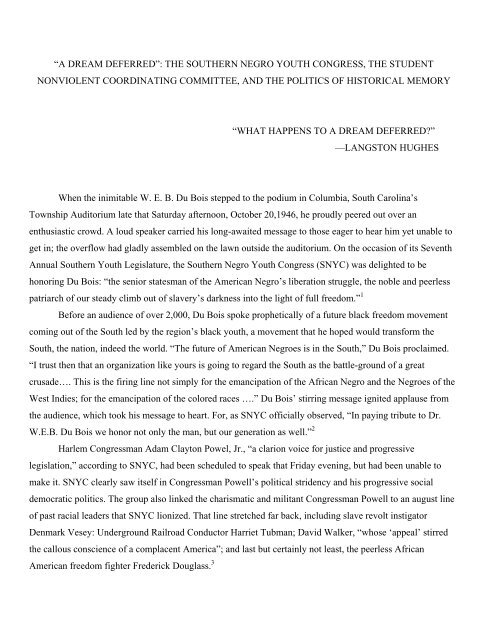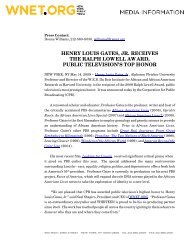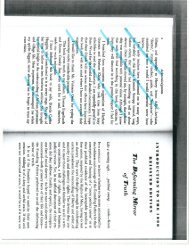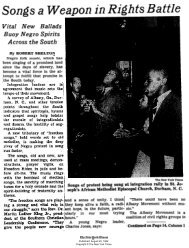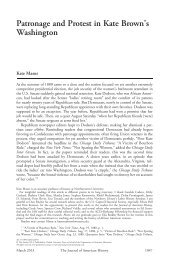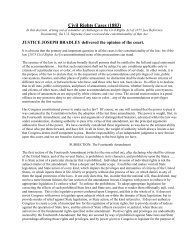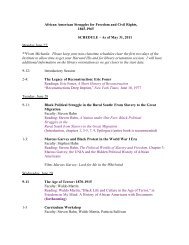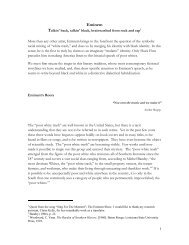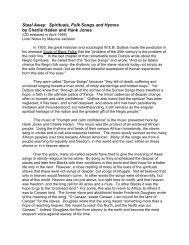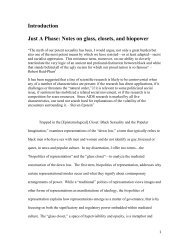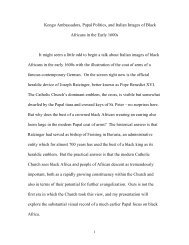SNYC, SNCC, Black Student Activism and the Making of the ...
SNYC, SNCC, Black Student Activism and the Making of the ...
SNYC, SNCC, Black Student Activism and the Making of the ...
Create successful ePaper yourself
Turn your PDF publications into a flip-book with our unique Google optimized e-Paper software.
“A DREAM DEFERRED”: THE SOUTHERN NEGRO YOUTH CONGRESS, THE STUDENT<br />
NONVIOLENT COORDINATING COMMITTEE, AND THE POLITICS OF HISTORICAL MEMORY<br />
“WHAT HAPPENS TO A DREAM DEFERRED?”<br />
—LANGSTON HUGHES<br />
When <strong>the</strong> inimitable W. E. B. Du Bois stepped to <strong>the</strong> podium in Columbia, South Carolina’s<br />
Township Auditorium late that Saturday afternoon, October 20,1946, he proudly peered out over an<br />
enthusiastic crowd. A loud speaker carried his long-awaited message to those eager to hear him yet unable to<br />
get in; <strong>the</strong> overflow had gladly assembled on <strong>the</strong> lawn outside <strong>the</strong> auditorium. On <strong>the</strong> occasion <strong>of</strong> its Seventh<br />
Annual Sou<strong>the</strong>rn Youth Legislature, <strong>the</strong> Sou<strong>the</strong>rn Negro Youth Congress (<strong>SNYC</strong>) was delighted to be<br />
honoring Du Bois: “<strong>the</strong> senior statesman <strong>of</strong> <strong>the</strong> American Negro’s liberation struggle, <strong>the</strong> noble <strong>and</strong> peerless<br />
patriarch <strong>of</strong> our steady climb out <strong>of</strong> slavery’s darkness into <strong>the</strong> light <strong>of</strong> full freedom.” 1<br />
Before an audience <strong>of</strong> over 2,000, Du Bois spoke prophetically <strong>of</strong> a future black freedom movement<br />
coming out <strong>of</strong> <strong>the</strong> South led by <strong>the</strong> region’s black youth, a movement that he hoped would transform <strong>the</strong><br />
South, <strong>the</strong> nation, indeed <strong>the</strong> world. “The future <strong>of</strong> American Negroes is in <strong>the</strong> South,” Du Bois proclaimed.<br />
“I trust <strong>the</strong>n that an organization like yours is going to regard <strong>the</strong> South as <strong>the</strong> battle-ground <strong>of</strong> a great<br />
crusade…. This is <strong>the</strong> firing line not simply for <strong>the</strong> emancipation <strong>of</strong> <strong>the</strong> African Negro <strong>and</strong> <strong>the</strong> Negroes <strong>of</strong> <strong>the</strong><br />
West Indies; for <strong>the</strong> emancipation <strong>of</strong> <strong>the</strong> colored races ….” Du Bois’ stirring message ignited applause from<br />
<strong>the</strong> audience, which took his message to heart. For, as <strong>SNYC</strong> <strong>of</strong>ficially observed, “In paying tribute to Dr.<br />
W.E.B. Du Bois we honor not only <strong>the</strong> man, but our generation as well.” 2<br />
Harlem Congressman Adam Clayton Powel, Jr., “a clarion voice for justice <strong>and</strong> progressive<br />
legislation,” according to <strong>SNYC</strong>, had been scheduled to speak that Friday evening, but had been unable to<br />
make it. <strong>SNYC</strong> clearly saw itself in Congressman Powell’s political stridency <strong>and</strong> his progressive social<br />
democratic politics. The group also linked <strong>the</strong> charismatic <strong>and</strong> militant Congressman Powell to an august line<br />
<strong>of</strong> past racial leaders that <strong>SNYC</strong> lionized. That line stretched far back, including slave revolt instigator<br />
Denmark Vesey: Underground Railroad Conductor Harriet Tubman; David Walker, “whose ‘appeal’ stirred<br />
<strong>the</strong> callous conscience <strong>of</strong> a complacent America”; <strong>and</strong> last but certainly not least, <strong>the</strong> peerless African<br />
American freedom fighter Frederick Douglass. 3
2<br />
Saturday Night’s headliner was none o<strong>the</strong>r than <strong>the</strong> incomparable Paul Robeson, ano<strong>the</strong>r <strong>SNYC</strong> hero.<br />
Robeson, <strong>the</strong>y explained, personified <strong>the</strong> best <strong>of</strong> world culture precisely because his “genius was wholly<br />
dedicated to <strong>the</strong> advancement <strong>of</strong> men toward a civilization <strong>of</strong> true bro<strong>the</strong>rhood.” He was “our modern-day<br />
Paul Bunyan …. Our Everyman, preaching <strong>the</strong> democratic idea <strong>and</strong> practicing what he preaches.” His<br />
greatness <strong>and</strong> influence was in fact global in reach. “Not only to Negro youth is he <strong>the</strong> shining symbol <strong>of</strong> our<br />
highest hopes <strong>and</strong> our growing courage; <strong>the</strong> oppressed <strong>and</strong> despised, <strong>the</strong> hopeful <strong>and</strong> striving men <strong>and</strong> women<br />
<strong>of</strong> all nations <strong>and</strong> colors know him as a friend <strong>and</strong> advocate. They love him as we do.” 4<br />
Four years earlier, in 1942, Robeson had given his first concert in <strong>the</strong> South at <strong>the</strong> Fifth All-Sou<strong>the</strong>rn<br />
Negro Youth conference at Tuskegee Institute in Tuskegee, Alabama. Previously, because <strong>of</strong> his principled<br />
refusal to sing before segregated audiences, Robeson had not performed in <strong>the</strong> Jim Crow South. On that mid-<br />
April night, for that special performance, however, <strong>SNYC</strong> assured Robeson that he would perform before an<br />
integrated audience. And he did, magnificently. <strong>SNYC</strong> stalwart Es<strong>the</strong>r Cooper Jackson later recalled that at<br />
that 1942 conference, “We ran into an older black woman as she came across <strong>the</strong> campus <strong>and</strong> very proudly<br />
announced, ‘There’s no segregation here tonight! Mr. Robeson is going to sing.’” 5 Four years later, in<br />
Columbia South Carolina, when Robeson reprised that earlier triumph in Tuskegee, that repeat triumph<br />
appeared to augur well for <strong>the</strong> future <strong>of</strong> his sponsors, <strong>the</strong> radical youth <strong>of</strong> <strong>SNYC</strong>.<br />
The Sou<strong>the</strong>rn Negro Youth Congress had begun a decade earlier, as <strong>the</strong> Great Depression went into its<br />
second downturn <strong>and</strong> <strong>the</strong> New Deal increasingly seemed like <strong>the</strong> same old deal <strong>and</strong> all too <strong>of</strong>ten worse, for<br />
blacks. <strong>SNYC</strong>, however, began on a very auspicious note, as <strong>the</strong> youth section <strong>of</strong> <strong>the</strong> National Negro<br />
Congress (NNC). The National Negro Congress had begun amid much hope <strong>and</strong> excitement in 1936 as an<br />
umbrella organization combining a spectrum <strong>of</strong> African American freedom struggle organizations <strong>and</strong><br />
personalities. This continuum encompassed conservatives <strong>and</strong> progressives, militant unionists, Socialists <strong>and</strong><br />
Communists, Democrats <strong>and</strong> Republicans, NAACP folk <strong>and</strong> Urban Leaguers. The National Negro Congress<br />
in effect started as a big-tent organization seeking to unite diverse elements within <strong>the</strong> <strong>Black</strong> Freedom<br />
Struggle. In spite <strong>of</strong> a spate <strong>of</strong> noteworthy achievements, particularly in pushing black unionization, <strong>the</strong><br />
Congress’ rocky history never matched that initial sense <strong>of</strong> hope <strong>and</strong> enthusiasm. 6<br />
In spite <strong>of</strong> <strong>the</strong> creation <strong>of</strong> <strong>the</strong> National Negro Congress, it immediately became clear to those active in<br />
<strong>the</strong> youth section <strong>of</strong> <strong>the</strong> Congress that an independent, sou<strong>the</strong>rn-based youth movement was imperative to<br />
push a dual yet interrelated agenda: <strong>the</strong> concerns <strong>of</strong> black youth specifically <strong>and</strong> blacks generally. In <strong>the</strong><br />
heady context <strong>of</strong> <strong>the</strong> wide-ranging social activism spawned by <strong>the</strong> Depression <strong>and</strong> <strong>the</strong> ga<strong>the</strong>ring clouds <strong>of</strong><br />
European war, youth activism mushroomed, especially among college youth. 7 <strong>SNYC</strong>’s founders <strong>and</strong> activists
youth.” 8 James Ashford, a <strong>SNYC</strong> organizer from Arkansas, was known for arguing with his nor<strong>the</strong>rn cohorts<br />
3<br />
were part <strong>of</strong> this yeasty moment <strong>and</strong> thus envisioned <strong>the</strong> organization as “an independent regional youth<br />
movement, not as a break away from <strong>the</strong> NNC.” The point was “to give particular attention to sou<strong>the</strong>rn<br />
that “our people aren’t going anywhere until <strong>the</strong>re’s a militant mass movement in <strong>the</strong> South.” In a like spirit,<br />
James Jackson, a <strong>SNYC</strong> organizer from Richmond, perceived <strong>the</strong> need for a training ground where <strong>the</strong> race’s<br />
future leaders would come toge<strong>the</strong>r to envision a better future, develop strategies to realize that future, <strong>and</strong><br />
<strong>the</strong>n work ceaselessly to bing that future about. Vital to this vision was <strong>the</strong> careful cultivation <strong>of</strong> <strong>the</strong> activist<br />
voices <strong>and</strong> works <strong>of</strong> sou<strong>the</strong>rn black youth. In large measure because <strong>of</strong> <strong>the</strong> extreme repressiveness <strong>of</strong> Jim<br />
Crow, <strong>the</strong> voices <strong>of</strong> sou<strong>the</strong>rn black youth were too <strong>of</strong>ten muffled <strong>and</strong> unheard, <strong>and</strong> <strong>the</strong>ir work within <strong>the</strong><br />
ongoing <strong>Black</strong> freedom Struggle too <strong>of</strong>ten silenced <strong>and</strong> ignored, if not crushed. Jackson later recalled sensing<br />
at <strong>the</strong> time <strong>the</strong> need for a progressive awakening among sou<strong>the</strong>rn black youth. “After some months it became<br />
clear,” he later recalled, “that sou<strong>the</strong>rn youth were not as aggressive <strong>and</strong> articulate in <strong>the</strong>ir pattern <strong>and</strong> style as<br />
<strong>the</strong> youth <strong>of</strong> <strong>the</strong> big cities <strong>of</strong> <strong>the</strong> North.” 9<br />
In stark contrast to <strong>the</strong> suffering <strong>and</strong> deprivation <strong>of</strong> <strong>the</strong> Depression, <strong>the</strong> resolution leading to <strong>the</strong><br />
founding <strong>of</strong> <strong>SNYC</strong> exuded youthful idealism <strong>and</strong> a gripping sense <strong>of</strong> historical possibility. The spirit<br />
animating <strong>the</strong> group at its beginning was both audacious <strong>and</strong> hopeful.<br />
We, <strong>the</strong> Youth Section <strong>of</strong> <strong>the</strong> national Negro Congress, realizing <strong>the</strong> vast possibilities in <strong>the</strong> millions<br />
<strong>of</strong> young people, unawakened <strong>and</strong> uninformed; <strong>the</strong> disinherited sharecropper, <strong>the</strong> tenant farmer, <strong>the</strong><br />
workers <strong>of</strong> <strong>the</strong> filed, young people whose future outlook is one <strong>of</strong> monotonous toil without any hope<br />
<strong>of</strong> security or happiness, resolved that we cast our lot with Sou<strong>the</strong>rn brethren knowing that ultimate<br />
success will not be achieved until <strong>the</strong> South is free. 10<br />
<strong>SNYC</strong>’s identifications were multiple <strong>and</strong> crosscutting: racial, age cohort, radical resistance, regional,<br />
national, <strong>and</strong> global. The organization’s identification with <strong>the</strong> South, where most blacks still lived, was<br />
crucial. A central <strong>the</strong>me throughout <strong>the</strong> organization’s history was <strong>the</strong> core belief that <strong>the</strong> most crucial terrain<br />
<strong>of</strong> <strong>the</strong> <strong>Black</strong> Freedom Struggle, where <strong>SNYC</strong> must <strong>the</strong>refore focus its energies, was in fact <strong>the</strong> South. The call<br />
for <strong>the</strong> initial conference set <strong>the</strong> tone <strong>and</strong> made <strong>the</strong> point. “We are <strong>the</strong> Negro Youth <strong>of</strong> <strong>the</strong> South. We are<br />
proud <strong>of</strong> every inch <strong>of</strong> Sou<strong>the</strong>rn soil. We <strong>and</strong> our fa<strong>the</strong>rs [<strong>and</strong> mo<strong>the</strong>rs] before us have given <strong>the</strong> toil <strong>and</strong><br />
sweat <strong>of</strong> our brow that <strong>the</strong> l<strong>and</strong> <strong>of</strong> our birth might prosper. We are proud <strong>of</strong> <strong>the</strong> generations <strong>of</strong> Negro people
4<br />
<strong>of</strong> <strong>the</strong> South, we are proud <strong>of</strong> <strong>the</strong> traditions <strong>of</strong> Frederick Douglass, Sojourner Truth, Nat Turner, Harriet<br />
Tubman.” 11<br />
The daunting challenge <strong>of</strong> ameliorating <strong>the</strong> suffering <strong>and</strong> deprivation <strong>of</strong> <strong>the</strong> Depression dem<strong>and</strong>ed<br />
concerted social <strong>and</strong> political youth activism. Jackson envisioned this uncommon challenge<br />
as <strong>the</strong> mission <strong>of</strong> <strong>the</strong> youth. That we had nothing to protect in terms <strong>of</strong> creature comforts. We had no<br />
wealth, no housing; we had only our needs <strong>and</strong> our hopes <strong>and</strong> dreams <strong>and</strong> aspirations. Therefore,<br />
youth could take <strong>the</strong> front ranks. Youth could do things that older people could not undertake for<br />
whatever reasons.. This was <strong>the</strong> challenge we accepted. We projected this program <strong>of</strong> urgent dem<strong>and</strong>s<br />
in all areas. 12<br />
Similarly, <strong>the</strong> call for <strong>the</strong> 1940 annual conference fur<strong>the</strong>r specified <strong>the</strong> role <strong>of</strong> progressive black youth<br />
in <strong>the</strong> evolving <strong>Black</strong> Freedom Struggle, noting that<br />
The world progresses in <strong>the</strong> heart <strong>and</strong> mind <strong>of</strong> its youth. A race climbs likewise. The Negro youth are<br />
<strong>the</strong> hope <strong>of</strong> <strong>the</strong>ir race, as <strong>the</strong> youth are <strong>the</strong> hope <strong>of</strong> every race. As Negro youth grow in underst<strong>and</strong>ing,<br />
life will be better for <strong>the</strong>m <strong>and</strong> for all <strong>of</strong> us, here in <strong>the</strong> South <strong>and</strong> elsewhere.<br />
Developing <strong>the</strong> “underst<strong>and</strong>ing” <strong>of</strong> Negro youth dem<strong>and</strong>ed education, politicization, <strong>and</strong> meaningful action.<br />
Coming toge<strong>the</strong>r on Wednesday February 13 <strong>and</strong> Thursday February 14 in 1936 what emerged as <strong>the</strong><br />
organizing conference <strong>of</strong> <strong>the</strong> Sou<strong>the</strong>rn Negro Youth Congress drew 534 excited <strong>and</strong> mostly sou<strong>the</strong>rn black<br />
delegates, including some 2,000 observers, to Richmond, Virginia’s Fifth Street Baptist Church. The dates<br />
were important: marking <strong>the</strong> birthdays <strong>of</strong> Frederick Douglass (February 14) 13 as well as Abraham Lincoln<br />
(February 12). Delegates included “students, farm h<strong>and</strong>s, sharecroppers, coal miners, domestic workers,’ as<br />
well as middle class pr<strong>of</strong>essionals <strong>and</strong> community members. Almost half <strong>of</strong> <strong>the</strong> delegates were young women.<br />
The average delegate age was twenty-two. The diverse group participated in workshops <strong>and</strong> heard from <strong>the</strong><br />
likes <strong>of</strong> John W. Davis, NNC’s Executive Secretary; Communist Party celebrity Angelo Herndon; <strong>and</strong>, Dr.<br />
Mordecai W. Johnson, Howard University’s first black President. The convention adopted resolutions calling<br />
for more <strong>and</strong> better jobs; better educational opportunities, including <strong>the</strong> teaching <strong>of</strong> Negro History; better<br />
health <strong>and</strong> recreational facilities; increased interracial activism; streng<strong>the</strong>ning black institutional life; <strong>and</strong>, full<br />
citizenship rights, notably untrammeled access to <strong>the</strong> ballot. 14
5<br />
A special highlight <strong>of</strong> <strong>the</strong> inaugural conference was Dr. Mordecai Johnson’s keynote address. In that<br />
speech, Johnson, a strong <strong>SNYC</strong> supporter over <strong>the</strong> years, praised <strong>the</strong> strength <strong>and</strong> audacity <strong>of</strong> <strong>the</strong> youth’s<br />
program <strong>and</strong> urged <strong>the</strong>m to bold action to achieve <strong>the</strong>ir goals. Deeply concerned about <strong>the</strong> protection <strong>of</strong> free<br />
speech <strong>and</strong> civil liberties, Johnson maintained that “The greatest danger to Democracy in America is not<br />
Communism or Socialism, but <strong>the</strong> political situation in which most men are no longer free to express<br />
<strong>the</strong>mselves.” In addition, Johnson urged <strong>the</strong> youth to think <strong>and</strong> act independently. Jackson recalled: “He<br />
challenged <strong>the</strong> youth not to be intimidated by <strong>the</strong> elders, to beware <strong>of</strong> <strong>the</strong> icy h<strong>and</strong> <strong>of</strong> tradition that would<br />
restrain <strong>the</strong> momentum <strong>and</strong> initiative <strong>of</strong> <strong>the</strong> young generation.” 15 Almost twenty-five years later, at <strong>the</strong><br />
founding <strong>of</strong> <strong>the</strong> <strong>Student</strong> Nonviolent Coordinating Committee in April 1960, legendary <strong>Black</strong> Freedom<br />
Activist Ella Baker similarly urged that generation <strong>of</strong> student activists to think <strong>and</strong> act independently, not to<br />
be constrained by <strong>the</strong> Civil Rights establishment. 16<br />
The organizational structure that emerged from that initial conference encompassed an Executive<br />
Committee led by an Executive Secretary <strong>and</strong> an Adult Advisory Board <strong>of</strong> notable elders. Dr. Frederick<br />
Patterson, President <strong>of</strong> Tuskegee Institute, headed up <strong>the</strong> Adult Advisory Board for most <strong>of</strong> <strong>the</strong> organization’s<br />
history. At <strong>the</strong> outset, that list included Charlotte Hawkins Brown, President <strong>of</strong> Palmer Memorial Institute; Du<br />
Bois, at that time a Pr<strong>of</strong>essor at Atlanta University; James Shepard, President <strong>of</strong> North Carolina Central<br />
College; Alain Locke, Howard University Pr<strong>of</strong>essor <strong>of</strong> Literature <strong>and</strong> Philosophy; <strong>and</strong> Fisk University<br />
sociologist Charles S. Johnson.<br />
Most important, a loose network <strong>of</strong> local councils <strong>and</strong> clubs conducted <strong>the</strong> actual grassroots work <strong>of</strong><br />
<strong>the</strong> Sou<strong>the</strong>rn Negro Youth Congress. That work, led by local youth leaders, included anti-lynching, voter<br />
registration, civil rights, labor organizing, educational, <strong>and</strong> health <strong>and</strong> recreational campaigns. That initial<br />
year saw <strong>the</strong> creation <strong>of</strong> at least twenty councils, drawing upon local high schools, colleges, labor locals, <strong>and</strong><br />
political <strong>and</strong> social organizations. The first national <strong>of</strong>fice found a home in <strong>the</strong> historic Consolidated Bank <strong>and</strong><br />
Trust Building in downtown Richmond home <strong>of</strong> <strong>the</strong> first American bank to be headed by a black woman,<br />
Maggie Lena Walker. When <strong>the</strong> Sou<strong>the</strong>rn Negro Youth Congress relocated to Birmingham, Alabama in 1939,<br />
<strong>the</strong> organization found a home in <strong>the</strong> black Masonic Temple Building. 17<br />
In mid-February 1936, at <strong>the</strong> inaugural meeting, hopes ran high, outstripping <strong>the</strong> anticipated anxiety.<br />
A young John Edwards from Richmond remembered, ”We felt that relief was finally on <strong>the</strong> way … this was<br />
going to be a turning point.” Dr. C.C. Scott, pastor <strong>of</strong> <strong>the</strong> Fifth Street Baptist Church <strong>and</strong> host <strong>of</strong> <strong>the</strong> inaugural<br />
<strong>SNYC</strong> convention, was very impressed. He was especially taken with <strong>the</strong> Sou<strong>the</strong>rn Negro Youth Congress’<br />
militancy <strong>and</strong> progressive politics, as well as <strong>the</strong> diversity <strong>of</strong> those in attendance, including a fair number <strong>of</strong>
6<br />
progressive whites. Particularly striking was <strong>the</strong> broad age range: “young adolescents, middle aged men <strong>and</strong><br />
women <strong>and</strong> old folks.” The range <strong>of</strong> political opinion was equally striking. “There were among <strong>the</strong>m<br />
Communists, Socialists, Democrats, Republicans <strong>and</strong> Catholics, as well as a few Jews thrown in for good<br />
measure.” 18<br />
Hosea Hudson, legendary black Communist <strong>and</strong> Alabama labor organizer, saw in <strong>the</strong> Sou<strong>the</strong>rn Negro<br />
Youth Congress a much-needed, indeed indispensable, organization dedicated to <strong>the</strong> <strong>Black</strong> Freedom Struggle:<br />
a militant <strong>and</strong> essential black sou<strong>the</strong>rn organization dedicated to <strong>the</strong> protection <strong>of</strong> black life <strong>and</strong> property <strong>and</strong><br />
<strong>the</strong> recognition <strong>and</strong> extension <strong>of</strong> black rights. Hudson explained that:<br />
We black people didn’t have no mass organization in <strong>the</strong> South before <strong>the</strong>n. Nobody said nothin’ .…<br />
police shoot down a Negro, it just a Negro shot down. Some may have grumbled among <strong>the</strong>mselves,<br />
but nobody said nothin’ …. 19<br />
The Sou<strong>the</strong>rn Negro Youth Congress not only said something, but also, like militant youth organizations in<br />
<strong>the</strong> 1960s, most notably <strong>the</strong> <strong>Student</strong> Nonviolent Coordinating Committee <strong>and</strong> <strong>the</strong> <strong>Black</strong> Pan<strong>the</strong>r Party for<br />
Self-Defense, <strong>the</strong> Sou<strong>the</strong>rn Negro Youth Congress actually did something. They not only protested<br />
rhetorically, but <strong>the</strong>y actively resisted; <strong>the</strong>y took concerted action. The Sou<strong>the</strong>rn Negro Youth Congress made<br />
<strong>the</strong> struggle against police brutality <strong>and</strong> racist lawlessness priorities, <strong>and</strong> in spite <strong>of</strong> <strong>the</strong> organization’s limited<br />
resources, <strong>the</strong>y labored diligently to alleviate <strong>the</strong>se galling wrongs. 20<br />
In <strong>the</strong> course <strong>of</strong> its first year, <strong>the</strong> Sou<strong>the</strong>rn Negro Youth Congress got <strong>of</strong>f to a rousing start. Easily <strong>the</strong><br />
most noteworthy achievement that initial year was <strong>the</strong> successful union organizing campaign <strong>SNYC</strong>C helped<br />
to mobilize against Richmond’s powerful British-American Tobacco Company. Led by James Jackson <strong>and</strong><br />
Chris Alston, Jackson’s friend <strong>and</strong> organizer for <strong>the</strong> upstart Congress <strong>of</strong> Industrial Organizations, or <strong>the</strong> CIO,<br />
<strong>the</strong> campaign garnered considerable <strong>SNYC</strong> support as well as widespread support within Richmond’s large<br />
black working class. As a youngster growing up in a solid middle class family near <strong>the</strong> factory where <strong>the</strong>se<br />
overworked <strong>and</strong> underpaid black women toiled, Jackson watched as <strong>the</strong>y passed by, <strong>of</strong>ten with children in<br />
tow, <strong>of</strong>ten before daybreak <strong>and</strong> after nightfall. The unconscionable inequity <strong>of</strong> it all seared Jackson’s<br />
consciousness.<br />
Principally through Jackson <strong>and</strong> Alston, <strong>the</strong> Sou<strong>the</strong>rn Negro Youth Congress worked intimately with<br />
<strong>the</strong>se struggling yet committed black women tobacco workers, whose oppression Jackson likened to that <strong>of</strong><br />
“chattel slaves.” The militant campaign featured meetings, strikes, jailings, <strong>and</strong> many tense moments. But,<br />
within several weeks, <strong>the</strong> more than 5,000 black workers prevailed, establishing <strong>the</strong> CIO-affiliated Tobacco<br />
Workers <strong>and</strong> Stemmers Industrial Union, achieving better working conditions <strong>and</strong> almost doubling <strong>the</strong> wages
7<br />
for its courageous <strong>and</strong> proud members. In <strong>the</strong> wake <strong>of</strong> this success, young organizers fanned out to places like<br />
Winston-Salem, Durham, <strong>and</strong> Raleigh to help create locals <strong>of</strong> <strong>the</strong> union. <strong>SNYC</strong>-assisted efforts to unionize<br />
domestics in certain communities exp<strong>and</strong>ed. In addition, worker’s education classes teaching reading, writing,<br />
<strong>and</strong> basic civics as well as <strong>the</strong> benefits <strong>of</strong> trade unionism evolved alongside <strong>the</strong>se organizing efforts. 21<br />
The first year also found <strong>the</strong> Sou<strong>the</strong>rn Negro Youth Congress involved in several o<strong>the</strong>r kinds <strong>of</strong><br />
programs. Deeply aware <strong>of</strong> <strong>the</strong> necessity <strong>of</strong> collaborating closely with established <strong>Black</strong> Freedom Struggle<br />
organizations <strong>and</strong> ongoing freedom struggle campaigns, <strong>SNYC</strong> worked with <strong>the</strong> NAACP on its anti-lynching<br />
campaign. Likewise, <strong>the</strong>y collaborated with <strong>the</strong> National Urban League in its vocational educational work.<br />
Reflecting <strong>SNYC</strong>’s core commitment to developing youth leadership, <strong>the</strong>y held that year in King’s Mountain,<br />
North Carolina, <strong>the</strong> first <strong>of</strong> a number <strong>of</strong> “Youth Leadership Training Seminars.” In a related vein, as part <strong>of</strong><br />
<strong>the</strong>ir core commitment to cultural work as essential to advancing <strong>the</strong> <strong>Black</strong> Freedom Struggle, <strong>the</strong>y created a<br />
Negro Community Theatre in Richmond under <strong>the</strong> leadership <strong>of</strong> Thomas Richardson. They also put on<br />
concerts featuring artists such as Rol<strong>and</strong> Hayes <strong>and</strong> <strong>the</strong> Eva Jessye Choir. Throughout its history, cultural<br />
work remained a key aspect <strong>of</strong> <strong>the</strong> Sou<strong>the</strong>rn Negro Youth Congress’ organizing <strong>and</strong> mobilizing campaigns.<br />
When <strong>the</strong> group met in Chattanooga, Tennessee from <strong>the</strong> first through <strong>the</strong> third <strong>of</strong> April 1938 for <strong>the</strong><br />
second annual convention, expectations <strong>and</strong> hopes ran high among <strong>the</strong> almost 400 delegates. For a small,<br />
fledgling, yet deeply committed black youth organization engaged in difficult, frustrating, <strong>and</strong> all too <strong>of</strong>ten<br />
dangerous grassroots political work, <strong>the</strong>se annual conventions were especially important as morale boosters,<br />
recruitment <strong>and</strong> publicity vehicles, <strong>and</strong> social events. In his “Greetings” to <strong>the</strong> delegates, Edward Strong made<br />
crystal clear that while hard work <strong>and</strong> hope were essential,<br />
Our problems today are acute. Three-quarter million <strong>of</strong> us are unemployed. One sixth <strong>of</strong> <strong>the</strong> nation’s<br />
youth have venereal diseases. One hundred thous<strong>and</strong> youth have been sent home from <strong>the</strong> CCC<br />
[Civilian Conservation Corps]. Five Scottsboro boys remain in prison. The fascist war lords are<br />
waging war against <strong>the</strong> Ethiopian, Austrian, Spanish, <strong>and</strong> Chinese young people. Our neighboring<br />
youth in Canada <strong>and</strong> Mexico are threatened by <strong>the</strong> blackest scourge <strong>of</strong> <strong>the</strong> modern world—fascism.<br />
And this black death has invaded our domain—America.<br />
The Sou<strong>the</strong>rn Negro Youth Congress was indeed acutely aware <strong>of</strong> <strong>the</strong> enormity <strong>of</strong> <strong>the</strong> challenges <strong>the</strong>y<br />
confronted. As a result, <strong>SNYC</strong> focused intently on how to “lay <strong>the</strong> practical basis to meet <strong>the</strong>m,” with<br />
precious few resources <strong>and</strong> limited clout at best. 22
8<br />
Undaunted, <strong>the</strong> “infant Congress” re-dedicated itself to its founding mission, as announced in its<br />
Proclamation <strong>of</strong> Sou<strong>the</strong>rn Negro Youth.<br />
We are <strong>the</strong> Negro Youth <strong>of</strong> <strong>the</strong> South. We are <strong>the</strong>y whose forebears have striven <strong>and</strong> suffered to create<br />
<strong>the</strong> wealth <strong>and</strong> beauty that crown our l<strong>and</strong>s today. Gr<strong>and</strong>sons <strong>and</strong> gr<strong>and</strong>daughters <strong>of</strong> slaves, we are <strong>the</strong><br />
third generation after <strong>the</strong> War Between <strong>the</strong> States; we have new chains which bind us, new shackles to<br />
be broken. In farms, in schools, in churches; in mines, mills, <strong>and</strong> factories, from Virginia’s Blue Ridge<br />
Mountains to <strong>the</strong> sou<strong>the</strong>rnmost tip <strong>of</strong> <strong>the</strong> Lone Star State, we st<strong>and</strong> determined that in this l<strong>and</strong> where<br />
our fa<strong>the</strong>rs died we shall win for ourselves <strong>and</strong> for all men “freedom, equality, <strong>and</strong> opportunity.” 23<br />
The 1942 Nora Wilson case perhaps captured at its best <strong>the</strong> grassroots activism <strong>of</strong> <strong>the</strong> Sou<strong>the</strong>rn Negro<br />
Youth Congress. An eighteen year-old teenager who lived with her family near Millbrook, Alabama, Nora<br />
Wilson had left school because her fa<strong>the</strong>r had contracted malaria <strong>and</strong> her mo<strong>the</strong>r, a sharecropper, needed help<br />
raising her six younger children. Upon learning that her eleven year-old sister Adrien had been accused by <strong>the</strong><br />
Woodburns, a neighboring white family, <strong>of</strong> stealing six ears <strong>of</strong> corn, Nora Wilson went to <strong>the</strong> Woodburn<br />
home to investigate. Ms. Wilson’s lack <strong>of</strong> servility outraged Mrs. Woodburn, who slapped Ms. Wilson<br />
because <strong>of</strong> her willingness to st<strong>and</strong> her ground <strong>and</strong> speak her mind. After Mrs. Woodburn apparently sought<br />
out a gun, Ms. Wilson left for home. Soon <strong>the</strong>reafter Nora Wilson was arrested for assault <strong>and</strong> battery with<br />
intent to kill, <strong>and</strong> her bail was set at $1,000. Without access to bail money <strong>and</strong> acting without <strong>the</strong> advice <strong>of</strong><br />
family, friends, <strong>and</strong> a lawyer, Ms. Wilson waived her right to a jury trial <strong>and</strong> was promptly convicted <strong>and</strong><br />
sentenced to prison in Wetumpka, Alabama Women’s Prison. The penalty came in two phases. First, for<br />
violating Jim Crow social norms <strong>and</strong> cursing a white woman, Ms. Wilson was given eight <strong>and</strong> one-half<br />
months. Second, at <strong>the</strong> conclusion <strong>of</strong> <strong>the</strong> first phase <strong>of</strong> punishment, Ms. Wilson was <strong>the</strong>n to st<strong>and</strong> trial for<br />
assault <strong>and</strong> battery with intent to kill. Tellingly, local authorities spurned Mrs. Woodburn’s request to have<br />
Ms. Wilson’s sentence dropped.<br />
The Sou<strong>the</strong>rn Negro Youth Congress first heard <strong>of</strong> Nora Wilson’s case through her mo<strong>the</strong>r, who<br />
shared her daughter’s desperate plight with <strong>the</strong> Caravan Puppeteers, a group — according to Johnetta<br />
Richards, <strong>the</strong> historian <strong>of</strong> <strong>SNYC</strong> — “<strong>of</strong> young black youths, under <strong>the</strong> auspices <strong>of</strong> <strong>the</strong> American Youth<br />
Congress <strong>and</strong> <strong>the</strong> Sou<strong>the</strong>rn Negro Youth Congress, who used puppet shows to entertain <strong>and</strong> inform rural<br />
sou<strong>the</strong>rn black people.” 24 The Caravan Puppeteers functioned as a popular cultural wing <strong>of</strong> <strong>SNYC</strong>, educating
9<br />
<strong>and</strong> entertaining rural sou<strong>the</strong>rn blacks about “<strong>the</strong> movement for <strong>the</strong> abolition <strong>of</strong> <strong>the</strong> poll tax, <strong>the</strong> drive for voter<br />
registration, <strong>the</strong> necessity <strong>of</strong> labor unions <strong>and</strong> <strong>the</strong> Sou<strong>the</strong>rn Negro Youth Congress.” 25<br />
That summer <strong>of</strong> 1942, upon hearing <strong>of</strong> <strong>the</strong> rank injustice <strong>of</strong> Nora Wilson’s case, <strong>the</strong> Caravan<br />
Puppeteers contacted <strong>SNYC</strong>’s Birmingham, Alabama national headquarters. Field Representative Arthur<br />
Price, working closely with Executive Secretary James Jackson, <strong>and</strong> Malcolm Dobbs <strong>of</strong> <strong>the</strong> League <strong>of</strong> Young<br />
Sou<strong>the</strong>rners (<strong>the</strong> youth division <strong>of</strong> <strong>the</strong> Sou<strong>the</strong>rn Conference for Human Welfare [1938-1948]) fought hard for<br />
her release. They hired a lawyer <strong>and</strong> created a publicity campaign, including a fundraising effort, pushing for<br />
her release in <strong>the</strong> media, petitions <strong>and</strong> telegrams. The Millbrook, Alabama Youth Council, consisting largely<br />
<strong>of</strong> Nora’s friends, formed to help with <strong>the</strong> campaign agitating for her release. The campaign to free Nora<br />
Wilson soon succeeded, as authorities dropped all <strong>the</strong> charges against her, even before she completed <strong>the</strong><br />
initial incarceration phase <strong>of</strong> her punishment. This victory for black civil liberties <strong>and</strong> Nora Wilson buoyed<br />
<strong>SNYC</strong>’s hopes. 26<br />
Six year later, in late April 1948, those hopes were on <strong>the</strong> ropes. A telegram to US Attorney General<br />
Tom Clark captured <strong>the</strong> imminent danger <strong>of</strong> <strong>the</strong> moment. Strenuous local white opposition threatened not<br />
only to disrupt <strong>the</strong> proceedings <strong>of</strong> <strong>the</strong> Sou<strong>the</strong>rn Negro Youth Congress’ annual meeting in Birmingham, but<br />
also to halt <strong>the</strong>m altoge<strong>the</strong>r. The telegram read:<br />
Every type <strong>of</strong> intimidation is being used by <strong>the</strong> Birmingham Commissioner <strong>of</strong> Public Safety, Eugene<br />
Bull Conner, <strong>and</strong> his <strong>of</strong>ficers to deprive our organization <strong>of</strong> <strong>the</strong> right to free assemblage in holding our<br />
biennial meeting scheduled to open today. He declares that he has <strong>the</strong> support <strong>of</strong> <strong>the</strong> Klan in his<br />
efforts. Citizen group conferences on this matter, coupled with <strong>the</strong> reign <strong>of</strong> terror here[,] force <strong>the</strong><br />
realization that <strong>the</strong> constituted authority <strong>of</strong> Birmingham <strong>of</strong>fers us no protection. We urge your<br />
immediate assistance[,] including <strong>of</strong>ficial telephonic contact with <strong>the</strong> commissioner. 27<br />
Not surprisingly, federal assistance never materialized.<br />
Sixteen years later, on <strong>the</strong> front lines <strong>of</strong> <strong>the</strong> <strong>Black</strong> Freedom Movement in McComb, Mississippi,<br />
besieged <strong>Student</strong> Nonviolent Coordinating Committee workers’ sense <strong>of</strong> frustration <strong>and</strong> alarm was similarly<br />
exacerbated by <strong>the</strong>n Attorney General Robert Kennedy’s inaction in <strong>the</strong> face <strong>of</strong> extreme white repression <strong>of</strong><br />
local black civil rights activism. Jesse Harris, director <strong>of</strong> <strong>SNCC</strong>’s McComb Project incessantly yet<br />
unsuccessfully pleaded for help with Burke Marshall, Attorney General Kennedy’s point man on Civil Rights.<br />
Harris argued that it was imperative that <strong>the</strong> Justice Department act upon its authority <strong>and</strong> intervene directly<br />
“to take action before it is too late.” Federal inaction, Harris pointed out, threatened <strong>the</strong> lives <strong>of</strong> those engaged<br />
in <strong>the</strong> McComb struggle. The <strong>of</strong>ficial federal view that police action in <strong>the</strong>se kinds <strong>of</strong> matters was a state
10<br />
ra<strong>the</strong>r than federal responsibility. Harris contended, was both dubious <strong>and</strong> unconscionable. When <strong>the</strong> US<br />
Attorney General “announces that <strong>the</strong>re is little <strong>the</strong> federal government can do to prevent a reign <strong>of</strong> terror in<br />
Mississippi, he has really given notice to every racist thug <strong>and</strong> vigilante in Mississippi, <strong>and</strong> throughout <strong>the</strong><br />
South, that … <strong>the</strong> present administration finds it politically inexpedient to exercise its constitutional<br />
m<strong>and</strong>ate.” 28<br />
Federal inaction in 1948 <strong>and</strong> in 1964 notwithst<strong>and</strong>ing, <strong>the</strong> African American Freedom Struggle<br />
persevered against <strong>of</strong>ten-terrible odds, in Birmingham, in McComb, throughout <strong>the</strong> South <strong>and</strong> <strong>the</strong> rest <strong>of</strong> <strong>the</strong><br />
nation. In Birmingham in late 1948, close to 200 battle-weary activists <strong>of</strong> <strong>the</strong> Sou<strong>the</strong>rn Negro Youth Congress<br />
had assembled from across <strong>the</strong> South with <strong>the</strong>ir characteristic high hopes <strong>and</strong> realistic expectations. Even in<br />
that increasingly anti-black, anti-radical, anti-labor, <strong>and</strong> anti-Communist moment, <strong>the</strong> Sou<strong>the</strong>rn Negro Youth<br />
Congress remained defiantly radical. Even in 1948, <strong>the</strong>y called for: <strong>the</strong> end to Jim Crow; <strong>the</strong> end to all<br />
barriers to voting; a strong national Fair Employment Practices Law; a federal anti-lynching law; equal<br />
educational opportunity; adequate housing, health care, recreational, <strong>and</strong> cultural facilities; <strong>the</strong> destruction <strong>of</strong><br />
white supremacy; <strong>and</strong> an end to Universal Military Training <strong>and</strong> related efforts to militarize American youth<br />
<strong>and</strong> create a third world war. 29<br />
A year before, in a 1947 press release, <strong>the</strong> Sou<strong>the</strong>rn Negro Youth Congress outlined “Eight Tasks for<br />
<strong>the</strong> 80 th Congress,” as central to <strong>the</strong>ir own social democratic program <strong>and</strong> as part <strong>of</strong> <strong>the</strong>ir lobbying effort in <strong>the</strong><br />
nation’s capital. Particularly noteworthy were <strong>the</strong> calls for a hike in <strong>the</strong> minimum wage, restoration <strong>of</strong> price<br />
controls, national health insurance, extension <strong>of</strong> Social Security benefits to “Domestic, Casual, <strong>and</strong><br />
Agricultural” laborers (categories in which blacks were overrepresented), <strong>and</strong> federal aid to education. 30<br />
Audaciously militant in <strong>the</strong>ir commitment to democracy, civil liberties, civil rights, <strong>and</strong> human rights,<br />
<strong>the</strong> Sou<strong>the</strong>rn Negro Youth Congress developed interracial as well as intraracial alliances, global as well as<br />
national links. Internationalist, <strong>the</strong>y staunchly supported <strong>the</strong> United Nations <strong>and</strong> anti-colonial struggles<br />
worldwide. Indeed <strong>the</strong>ir foundational commitment to democratic self-determination as well as<br />
internationalism led <strong>the</strong>m to work with progressive whites in youth organizations like <strong>the</strong> American <strong>Student</strong><br />
Congress <strong>and</strong> <strong>the</strong> World <strong>Student</strong> Congress. As noted earlier, it also meant working with progressive sou<strong>the</strong>rn<br />
whites in organizations like <strong>the</strong> Sou<strong>the</strong>rn Conference for Human Welfare (SCHW) <strong>and</strong> its youth wing, <strong>the</strong><br />
League <strong>of</strong> Young Sou<strong>the</strong>rners, <strong>and</strong> <strong>the</strong> Sou<strong>the</strong>rn Conference Educational Fund(SCEF), which in 1946 grew<br />
out <strong>of</strong> SCHW.<br />
Vigorously pro-labor <strong>and</strong> pro-worker’s rights, as evidenced in <strong>the</strong> Sou<strong>the</strong>rn Negro Youth Congress’<br />
close working relationship with <strong>the</strong> CIO, <strong>SNYC</strong> likewise forged ties with <strong>the</strong> AFL. The point was to “spread a
11<br />
labor consciousness among blacks,” or more specifically to build black support for <strong>the</strong> train union movement.<br />
To advance <strong>the</strong> cause <strong>of</strong> organized labor among blacks <strong>SNYC</strong> sponsored labor youth clubs. Economic justice<br />
rooted in a fair <strong>and</strong> livable wage for workers was always a primary plank in <strong>SNYC</strong>’s platform. In “The Tasks<br />
<strong>of</strong> our Generation,” <strong>SNYC</strong> Executive Secretary Edward K. Weaver observed in 1948 that “Winning economic<br />
security depends on <strong>the</strong> concrete things which we can do to eliminate <strong>the</strong> degradation <strong>of</strong> sharecropping,<br />
reduce skyrocketing prices, free <strong>the</strong> trade unions from <strong>the</strong> crippling burden <strong>of</strong> <strong>the</strong> vengeful Taft-Hartley law,<br />
<strong>and</strong> improve <strong>the</strong> position <strong>of</strong> negro workers within <strong>the</strong> unions. We must also win for Negro youth equal<br />
chances for apprenticeship <strong>and</strong> on-<strong>the</strong>-job training <strong>and</strong> up-to-date guidance.” 31<br />
The Sou<strong>the</strong>rn Negro Youth Congress’ bold vision <strong>of</strong> <strong>and</strong> unwavering commitment to black youth<br />
activism appealed to innumerable blacks, including <strong>the</strong> venerable Alain Locke. Locke likened <strong>SNYC</strong> to o<strong>the</strong>r<br />
important contemporary youth movements around <strong>the</strong> globe, including <strong>the</strong> All Indian Nationalist movement,<br />
<strong>the</strong> Young Egyptians, <strong>the</strong> Young Turks, <strong>and</strong> <strong>the</strong> Zionist Movement. In 1940, Locke enthusiastically<br />
characterized <strong>SNYC</strong> as “<strong>the</strong> most historic development among sou<strong>the</strong>rn Negroes since Reconstruction.” 32<br />
Not surprisingly, <strong>the</strong> Sou<strong>the</strong>rn Negro Youth Congress’s radical politics alienated some within <strong>the</strong><br />
black community. The fact that <strong>SNYC</strong> included Communists among its founders <strong>and</strong> most prominent<br />
members alienated a number <strong>of</strong> blacks as well, many <strong>of</strong> whom reflected <strong>the</strong> increasingly staunch anti-<br />
Communism <strong>of</strong> <strong>the</strong> era. This was especially <strong>the</strong> case as <strong>the</strong> anti-Communist crusade <strong>and</strong> its associated early<br />
Cold War hysteria waxed in <strong>the</strong> late 1940s.<br />
Never<strong>the</strong>less, as late as 1948, <strong>the</strong> year after <strong>SNYC</strong> made <strong>the</strong> Attorney General’s list <strong>of</strong> subversive<br />
organizations, <strong>the</strong> group listed among its eminent sponsors former Dean <strong>of</strong> <strong>the</strong> Howard Law School Charles<br />
T. Houston, a key early architect <strong>of</strong> <strong>the</strong> NAACP legal strategy that culminated in <strong>the</strong> Brown decision; Charles<br />
G. Gomilion, head <strong>of</strong> <strong>the</strong> Education Department at Tuskegee; <strong>and</strong> Lu<strong>the</strong>r Porter Jackson, Pr<strong>of</strong>essor <strong>of</strong> History<br />
at Virginia State College in Petersburg, Virginia. The Advisory Board still listed Dr. Charlotte Hawkins<br />
Brown <strong>and</strong> Mrs. Mary McLeod Bethune, New Deal <strong>of</strong>ficial <strong>and</strong> friend <strong>of</strong> Eleanor Roosevelt. Within <strong>the</strong> year,<br />
however, <strong>the</strong> Sou<strong>the</strong>rn Negro Youth Congress ceased operations, hounded out <strong>of</strong> existence as part <strong>of</strong> <strong>the</strong><br />
exp<strong>and</strong>ing Communist witch hunt. This moment also began <strong>SNYC</strong>’s slide into historical oblivion, an oblivion<br />
that has recently lifted in large part because <strong>of</strong> a spate <strong>of</strong> important scholarship <strong>and</strong> <strong>the</strong> end <strong>of</strong> <strong>the</strong> Cold War.<br />
LEGACY, POLITICS, AND HISTORICAL MEMORY
12<br />
The historical importance <strong>of</strong> <strong>the</strong> Sou<strong>the</strong>rn Negro Youth Congress is undeniable. Without a mass<br />
African American insurgency to sustain it <strong>and</strong> without <strong>the</strong> support <strong>of</strong> sympa<strong>the</strong>tic segments within <strong>the</strong><br />
American media, as we saw in <strong>the</strong> Civil Rights-<strong>Black</strong> Power Insurgency <strong>of</strong> <strong>the</strong> post-World War II era, <strong>SNYC</strong><br />
blazed a bold <strong>Black</strong> freedom struggle path that merits far more scholarly analysis. In effect, why has <strong>the</strong><br />
history <strong>of</strong> <strong>the</strong> Sou<strong>the</strong>rn Negro Youth Congress not yet found its place in <strong>the</strong> emerging history <strong>of</strong> <strong>the</strong> twentiethcentury<br />
<strong>Black</strong> Freedom Movement narrative? In addition, <strong>the</strong>re is as <strong>of</strong> yet no full-scale history <strong>of</strong> twentiethcentury<br />
African American youth/student activism. The question must be asked, though: what would such a<br />
history encompass <strong>and</strong> what role would <strong>SNYC</strong> play in it?<br />
Current historical underst<strong>and</strong>ing centers <strong>SNCC</strong> <strong>and</strong> its history as <strong>the</strong> central story in <strong>the</strong> yet-to-be<br />
written but emerging narrative <strong>of</strong> twentieth century African American youth/student activism. As historians,<br />
we are still plotting what went before <strong>SNCC</strong> <strong>and</strong> what came after it. I want to suggest two things. First,<br />
precisely because <strong>of</strong> its singular significance, <strong>SNYC</strong>’s history must be fully understood on its own terms.<br />
Second, in crucial ways that dem<strong>and</strong> critical analysis, <strong>SNYC</strong> paved <strong>the</strong> way for <strong>SNCC</strong> as well as <strong>the</strong> modern<br />
Civil Rights-<strong>Black</strong> Power Movement. As a result, <strong>SNYC</strong>’s history must be an integral component <strong>of</strong> both a<br />
history yet-to-be-written <strong>of</strong> twentieth-century African American youth/student activism as well as a revised<br />
narrative <strong>of</strong> <strong>the</strong> twentieth century African American Freedom Movement.<br />
In spite <strong>of</strong> <strong>the</strong> differences between <strong>the</strong> <strong>Student</strong> Nonviolent Coordinating Committee <strong>and</strong>, even, <strong>the</strong><br />
<strong>Black</strong> Pan<strong>the</strong>r Party, on one h<strong>and</strong>, <strong>and</strong> <strong>the</strong> Sou<strong>the</strong>rn Negro Youth Congress, on <strong>the</strong> o<strong>the</strong>r, <strong>the</strong>re were<br />
compelling similarities among <strong>the</strong>m as youth/student movements <strong>and</strong> as key organizations in <strong>the</strong> history <strong>of</strong> <strong>the</strong><br />
modern <strong>Black</strong> Freedom Movement. These similarities, as well as differences, merit thorough historical<br />
investigation. While <strong>SNCC</strong> will likely still comm<strong>and</strong> center stage, at least for crucial moments, in both <strong>of</strong><br />
<strong>the</strong>se histories, <strong>SNCC</strong> must share <strong>the</strong> historical stage. Indeed a most revealing feature <strong>of</strong> <strong>the</strong> dominant<br />
representations <strong>of</strong> <strong>the</strong> history <strong>of</strong> <strong>SNCC</strong>, <strong>and</strong> to a lesser extent <strong>the</strong> <strong>Black</strong> Pan<strong>the</strong>r Party, is its insularity from a<br />
history, a genealogy, <strong>of</strong> previous <strong>and</strong> subsequent African American student movements <strong>and</strong> protests. 33 The<br />
effect is to render <strong>SNCC</strong>’s powerful <strong>and</strong> extraordinary history “sui generis,” as exceptional, as fundamentally<br />
unique in African American experience, as essentially apart from what went on before <strong>and</strong> subsequently. Such<br />
a history becomes virtually trans-historical. This <strong>of</strong> course we know to be historically inaccurate. Still, <strong>the</strong><br />
question persists: Why has <strong>SNCC</strong> come to represent twentieth-century African American youth/student<br />
activism to <strong>the</strong> virtual exclusion <strong>of</strong> all o<strong>the</strong>r African America youth/student organizations? What uses,<br />
functions, <strong>and</strong> interests does this particular historical portrait serve? How do we craft a fuller, richer, more
13<br />
accurate history <strong>of</strong> twentieth-century African American youth/student activism? In turn, how do we craft a<br />
fuller, richer, more accurate history <strong>of</strong> <strong>the</strong> twentieth-century African American Freedom Movement?<br />
Several explanations help us to underst<strong>and</strong> why, how, <strong>and</strong> with what consequences <strong>SNCC</strong> dominates<br />
scholarly <strong>and</strong> popular underst<strong>and</strong>ings <strong>of</strong> twentieth-century African American youth/student activism. First, as<br />
previously suggested, <strong>SNCC</strong>’s actual centrality to <strong>the</strong> modern African American Civil Rights-<strong>Black</strong> Power<br />
Movements in large measure accounts for this fact. Put ano<strong>the</strong>r way, <strong>SNCC</strong>’s historical significance is<br />
powerful <strong>and</strong> <strong>the</strong>refore undeniable. Second, <strong>SNCC</strong>’s history is a vital element <strong>of</strong> <strong>the</strong> most felt <strong>and</strong> enduring<br />
narrative representations <strong>of</strong> <strong>the</strong> modern African American Freedom Movement. Third, scholars, activists, <strong>and</strong><br />
SNNCC veterans have kept alive not only <strong>the</strong> memory <strong>of</strong> <strong>SNCC</strong>, but also striking visions <strong>of</strong> SNNC’s<br />
historical singularity.<br />
Those engaged in presenting <strong>and</strong> analyzing <strong>the</strong> history <strong>of</strong> <strong>the</strong> Sou<strong>the</strong>rn Negro Youth Congress,<br />
however, must necessarily overcome <strong>the</strong> amnesia <strong>and</strong> neglect that all too <strong>of</strong>ten afflicts black radical histories,<br />
notably those with significant Communist story lines. Only in <strong>the</strong> last few decades have we begun to come<br />
out from under <strong>the</strong> related Cold War-Anti-Communist hysteria that shaped American popular <strong>and</strong> scholarly<br />
underst<strong>and</strong>ing <strong>and</strong> practice. While its enemies <strong>of</strong>ten charged that it was Communist, or worse, <strong>SNCC</strong> was not.<br />
Unlike <strong>SNYC</strong>, which embraced its Communist affiliations, for better <strong>and</strong> for worse, <strong>SNCC</strong> steered away from<br />
any such affiliations, for <strong>the</strong> obvious reasons. Seen ano<strong>the</strong>r way, in <strong>the</strong> necessary search for historical<br />
inclusion <strong>and</strong> legitimacy, those telling <strong>and</strong> writing <strong>the</strong> stories <strong>of</strong> <strong>the</strong> Sou<strong>the</strong>rn Negro Youth Congress have<br />
necessarily battled <strong>the</strong> anti-radical <strong>and</strong> anti-Communist biases<br />
<strong>of</strong> popular <strong>and</strong> scholarly underst<strong>and</strong>ing <strong>and</strong> practice.<br />
An especially telling aspect <strong>of</strong> this troubling legacy has been not simply <strong>the</strong> scholarly effort to<br />
disassociate <strong>and</strong> separate <strong>the</strong> histories <strong>of</strong> <strong>the</strong> Sou<strong>the</strong>rn Negro Youth Congress <strong>and</strong> <strong>the</strong> <strong>Student</strong> Nonviolent<br />
Coordinating Committee, but also to minimize <strong>the</strong> historical significance <strong>and</strong> impact <strong>of</strong> <strong>SNYC</strong>. The shameful<br />
redbaiting <strong>and</strong> disremembering <strong>of</strong> <strong>SNYC</strong> has shaped <strong>the</strong> received yet flawed wisdom <strong>of</strong> <strong>the</strong> fundamental<br />
discontinuity between <strong>SNYC</strong> <strong>and</strong> <strong>SNCC</strong>. The point here is not to suggest that <strong>the</strong>re were not discontinuities<br />
between <strong>the</strong>se organizations, because <strong>the</strong>re clearly were. Ra<strong>the</strong>r, <strong>the</strong> point here is to suggest that <strong>the</strong>re were<br />
also continuities between <strong>the</strong>m. While <strong>the</strong> complexities <strong>of</strong> differing historical contexts shaped <strong>the</strong>se<br />
discontinuities, similarities <strong>of</strong> aspiration, vision, <strong>and</strong> consciousness shaped <strong>the</strong>se continuities.<br />
Envisioning <strong>the</strong> Sou<strong>the</strong>rn Negro Youth Congress has <strong>of</strong>ten meant seeing it in relation to <strong>the</strong> <strong>Student</strong><br />
Nonviolent Coordinating Committee, as paving <strong>the</strong> way for both <strong>SNCC</strong> <strong>and</strong> <strong>the</strong> modern African American<br />
Freedom Movement. The opposite is not true, however. In large part out <strong>of</strong> widespread ignorance <strong>of</strong> <strong>SNYC</strong>’s
14<br />
history, few <strong>SNCC</strong> folk at <strong>the</strong> time saw <strong>the</strong>mselves in <strong>SNYC</strong>, <strong>and</strong>, as noted previously, scholarship <strong>and</strong><br />
popular underst<strong>and</strong>ing reflects this notion. 34 <strong>SNCC</strong> veterans, like <strong>the</strong> legendary Robert Moses, admit that <strong>the</strong>y<br />
simply had no prior knowledge <strong>of</strong> <strong>SNYC</strong>, notably as <strong>the</strong>y created early <strong>SNCC</strong>. Yet, even as <strong>SNCC</strong> veterans<br />
<strong>and</strong> scholars <strong>of</strong> <strong>SNCC</strong> have learned <strong>of</strong> <strong>SNYC</strong>’s history, this knowledge has not substantially altered <strong>the</strong><br />
insularity <strong>and</strong> narrowness <strong>of</strong> <strong>SNCC</strong>’s origins narratives. 35<br />
The venerable Ella Baker, <strong>SNCC</strong>’s midwife, clearly knew <strong>of</strong> <strong>SNYC</strong>. Baker herself came <strong>of</strong> age<br />
politically in 1930s New York City, working in a cauldron <strong>of</strong> activism, especially youth/student activism. For<br />
a time she worked in George Schuyler’s Young Negroes Cooperative League. The lessons learned from<br />
<strong>SNYC</strong>’s history, in particular its demise at <strong>the</strong> h<strong>and</strong>s <strong>of</strong> Red Scare-Cold War repression, were not lost on Ms.<br />
Baker. While no militant anti-Communist herself, she fully understood that <strong>SNCC</strong> must remain independent,<br />
non-sectarian <strong>and</strong> as non-ideological as possible. As noted previously, her pr<strong>of</strong>oundly influential counsel<br />
steered <strong>SNCC</strong> in that direction. While <strong>SNCC</strong> was created in <strong>the</strong> throes <strong>of</strong> <strong>the</strong> rapidly developing Sit-In phase<br />
<strong>of</strong> <strong>the</strong> Civil rights Movement, at <strong>the</strong> time <strong>the</strong>re was apparently no substantial discussion <strong>of</strong> <strong>the</strong> history <strong>of</strong><br />
African-American youth/student activism, such as that <strong>of</strong> <strong>the</strong> Sou<strong>the</strong>rn Negro Youth Congress. 36<br />
Howard Zinn, ano<strong>the</strong>r <strong>of</strong> <strong>the</strong> early adult advisors to <strong>SNCC</strong>, like Baker, was not a knee-jerk anti-<br />
Communist. At <strong>the</strong> moment <strong>of</strong> <strong>SNCC</strong>’s founding, he, too, saw <strong>the</strong> organization’s non-ideological focus, its<br />
non-sectarianism, as a strength ra<strong>the</strong>r than a liability. In turn, Zinn touched upon a paradox that underlay<br />
<strong>SNCC</strong>’s viability, notwithst<strong>and</strong>ing its radicalism, especially in <strong>the</strong> early 1960s. Speaking to Daniel Bell’s<br />
consensus vision <strong>of</strong> The End <strong>of</strong> Ideology in postwar America, this paradox was <strong>the</strong> non-ideological character<br />
<strong>of</strong> “’participation in ideological movements today.’” As Zinn observed in his invaluable 1964 attempt “to<br />
suggest <strong>the</strong> quality <strong>of</strong> <strong>the</strong>ir contribution to American civilization,” <strong>SNCC</strong> had “a different quality that that <strong>of</strong><br />
earlier American student movements—<strong>the</strong> radical student movements <strong>of</strong> <strong>the</strong> thirties”: to reiterate — <strong>the</strong> nonideological<br />
character <strong>of</strong> this ideological movement. 37 In o<strong>the</strong>r words, early <strong>SNCC</strong> sidestepped <strong>the</strong> radical<br />
partisan politics that enlivened youth/student movements <strong>of</strong> <strong>the</strong> 1930s <strong>and</strong> contributed to <strong>the</strong>ir undoing when<br />
<strong>the</strong> antiradicalism <strong>of</strong> <strong>the</strong> Red Scare-Cold War was unleashed.<br />
Zinn explained that unlike youth/student activists <strong>of</strong> <strong>the</strong> 1930s, apparently like those <strong>of</strong> <strong>SNYC</strong>, <strong>the</strong><br />
1960s youth/student activists <strong>of</strong> <strong>SNCC</strong> “have not become followers <strong>of</strong> any dogma, have not pledged<br />
<strong>the</strong>mselves to ant rigid ideological system. Unswerving as <strong>the</strong>y are in moving towards certain basic goals,<br />
<strong>the</strong>y wheel freely in <strong>the</strong>ir thinking about society <strong>and</strong> how it needs to be changed.” In essence, <strong>SNCC</strong> activists<br />
“are radical, but not dogmatic: thoughtful, but not ideological. Their thinking is undisciplined; it is fresh, <strong>and</strong><br />
it is new.” At ano<strong>the</strong>r point, he likewise noted that “These are young radicals; <strong>the</strong> word ‘revolution’ occurs
15<br />
again <strong>and</strong> again in <strong>the</strong>ir speech. Yet <strong>the</strong>y have no party, no ideology, no creed. They have no clear idea <strong>of</strong> a<br />
blueprint for future society.” 38 In fact, this characterization might easily have been applied to many if not<br />
most <strong>SNYC</strong> activists as well.<br />
Put ano<strong>the</strong>r way, as acknowledged earlier, <strong>SNCC</strong> was nei<strong>the</strong>r Communist nor Communist-inspired,<br />
<strong>and</strong> most assuredly not a Communist Front. Consequently, unlike <strong>SNYC</strong>, <strong>SNCC</strong> could successfully resist <strong>the</strong><br />
redbaiting <strong>of</strong> its opponents. In Zinn’s estimation:<br />
The talk about “Communist” influences in <strong>SNCC</strong> comes mostly from people who simply don’t know<br />
<strong>the</strong> organization, or <strong>the</strong> people in it. <strong>SNCC</strong> is fundamentally a group <strong>of</strong> <strong>Black</strong> Belt <strong>and</strong> Nor<strong>the</strong>rn<br />
Negroes who are angry at American Society <strong>and</strong> determined to change it, who have little or no contact<br />
with formal racial ideologies or movements. Here <strong>and</strong> <strong>the</strong>re may be one or two people at intermediate<br />
levels on <strong>the</strong> <strong>SNCC</strong> staff who’ve read a little Marx <strong>and</strong> are consciously sympa<strong>the</strong>tic with one or<br />
ano<strong>the</strong>r communist or socialist governments in <strong>the</strong> world.<br />
Zinn perceptively noted that in 1964 “<strong>the</strong>re is no single meaning <strong>of</strong> ‘Communism’ or ‘Communist.’” Instead<br />
<strong>the</strong>re are “varieties <strong>of</strong> communism … in different parts <strong>of</strong> <strong>the</strong> world.” A bit over-optimistically, he concluded<br />
that “<strong>the</strong> term … has lost its capacity to alarm.” 39<br />
In 1964 <strong>the</strong> Cold War-Red Scare propag<strong>and</strong>a machine had functionally erased <strong>the</strong> Sou<strong>the</strong>rn Negro<br />
Youth Congress from American historical consciousness. In a sense, that omnipresent <strong>and</strong> highly repressive<br />
machine relegated <strong>SNYC</strong> —<strong>and</strong> comparable organizations, moments, <strong>and</strong> personalities — to a kind <strong>of</strong><br />
historical oblivion, historical purgatory, or historical ne<strong>the</strong>rworld,. This is <strong>the</strong> domain <strong>of</strong> <strong>the</strong> truly forgotten<br />
<strong>and</strong> neglected, <strong>of</strong> deeply repressed historical memory. It is also <strong>the</strong> domain <strong>of</strong> <strong>the</strong> historically trivialized <strong>and</strong><br />
misrepresented.<br />
Unfortunately, historians, those entrusted with <strong>the</strong> responsibility to get it right, to get to <strong>the</strong> “historical<br />
truth,” likewise fell victim to <strong>the</strong> truth-defying Cold War-Red Scare propag<strong>and</strong>a machine. Ra<strong>the</strong>r than search<br />
out <strong>and</strong> establish <strong>the</strong> “historical truth,” <strong>the</strong>y succumbed to a version <strong>of</strong> events framed by head anti-Communist<br />
spook J. Edgar Hoover. W.E. B. Du Bois’ insight in ano<strong>the</strong>r context, that <strong>of</strong> <strong>the</strong> massively distorted <strong>and</strong><br />
viciously racist historical caricatures <strong>of</strong> <strong>Black</strong> Reconstruction for most <strong>of</strong> <strong>the</strong> twentieth century, ring painfully<br />
true in this context. Du Bois explained: as scholars “we are blind <strong>and</strong> led by <strong>the</strong> blind. And why? Because …<br />
we fell under <strong>the</strong> leadership <strong>of</strong> those who would compromise with truth in <strong>the</strong> past in order to make peace in<br />
<strong>the</strong> present <strong>and</strong> guide policy in <strong>the</strong> future.” 40
16<br />
Even in 2013, long after <strong>the</strong> formal end <strong>of</strong> <strong>the</strong> Red Scare-Cold War era, that period’s insidious<br />
intellectual <strong>and</strong> political effects persist. Far too <strong>of</strong>ten Movement scholarship still remains unable to see “<strong>the</strong><br />
beloved community” <strong>of</strong> <strong>SNCC</strong> in <strong>SNYC</strong> not only because <strong>of</strong> a lack <strong>of</strong> knowledge about <strong>SNYC</strong>, but also<br />
because <strong>of</strong> <strong>the</strong> involvement <strong>of</strong> radical black Communists in <strong>the</strong> latter. Even armed with basic knowledge <strong>of</strong><br />
<strong>SNYC</strong> as a progressive <strong>Black</strong> Freedom organization, a clear forerunner <strong>of</strong> SNNC, this scholarship too <strong>of</strong>ten<br />
ei<strong>the</strong>r ignores or pays lip service to <strong>SNYC</strong> <strong>and</strong> those who went before. Conventional scholarship all too <strong>of</strong>ten<br />
not only ignores <strong>SNYC</strong>, but also reinforces <strong>the</strong> misperception <strong>of</strong> <strong>SNYC</strong> <strong>and</strong> like organizations as<br />
unrepresentative, as outliers, as exceptions to <strong>the</strong> norm <strong>and</strong> <strong>the</strong> rule <strong>of</strong> <strong>SNCC</strong>. These moves reiterate <strong>the</strong><br />
master narratives <strong>of</strong> consensus <strong>and</strong> discontinuity, all <strong>the</strong> while replicating <strong>the</strong> historical line <strong>of</strong> <strong>SNCC</strong>’s<br />
historical distinctiveness, ignoring <strong>the</strong> continuities between <strong>SNYC</strong> <strong>and</strong> <strong>SNCC</strong>. 41<br />
It must be acknowledged, <strong>of</strong> course, that some kinds <strong>of</strong> links are more easily acknowledged than<br />
o<strong>the</strong>rs. It is not unusual for <strong>SNCC</strong> veterans <strong>and</strong> scholars <strong>of</strong> <strong>SNCC</strong> to see <strong>the</strong> organization in less ideologically<br />
charged personalities like G<strong>and</strong>hi, <strong>and</strong> less ideologically charged movements like Berkeley’s 1964 Free<br />
Speech Movement <strong>and</strong> <strong>the</strong> Anti-Apar<strong>the</strong>id Movement <strong>of</strong> <strong>the</strong> 1980s. Similarly, as evidenced by Sinn’s<br />
resonant characterization <strong>of</strong> SNN activists in 1964 as <strong>the</strong> “new abolitionists,” it is easier to see <strong>SNCC</strong> in<br />
earlier, less-ideologically driven radical social movements like nineteenth-century American abolitionism. 42<br />
Yet seeing <strong>SNCC</strong> in <strong>the</strong> comparable <strong>and</strong> more directly related radical lineage <strong>of</strong> <strong>SNYC</strong>, however, has thus far<br />
proven more difficult, if not impossible.<br />
One <strong>of</strong> <strong>the</strong> elite African American supporters <strong>of</strong> <strong>the</strong> Sou<strong>the</strong>rn Negro Youth Congress in <strong>the</strong> early<br />
1940s was Lincoln University President Horace Mann Bond. Because <strong>of</strong> <strong>the</strong> anti-Communist witch-hunt<br />
against <strong>the</strong> organization in <strong>the</strong> mid-forties, however, President Bond, like many <strong>of</strong> <strong>the</strong> former elite African<br />
American supporters <strong>of</strong> <strong>SNYC</strong>, disassociated <strong>the</strong>mselves from <strong>the</strong> organization. Over a decade later, Julian<br />
Bond, President Bond’s son <strong>and</strong> storied <strong>SNCC</strong> <strong>and</strong> Civil rights stalwart, helped to start <strong>the</strong> 1960 Atlanta Sit-In<br />
Movement while a student at Morehouse College. Only later, much later in fact, did he learn <strong>of</strong> <strong>SNYC</strong>. In his<br />
Foreword to <strong>the</strong> Freedomways Reader (2000), he acknowledged that <strong>the</strong> modern Civil Rights Movement had<br />
“roots as much in <strong>the</strong> 1860s as <strong>the</strong> 1950s, <strong>the</strong> 1940s, <strong>and</strong> <strong>the</strong> 1930s.” Likewise, in A Circle <strong>of</strong> Trust:<br />
Remembering <strong>SNCC</strong>, Cheryl Greenberg speaks <strong>of</strong> <strong>SNCC</strong> having modeled itself “on preceding grass-roots<br />
political struggles, especially those <strong>of</strong> Moh<strong>and</strong>as G<strong>and</strong>hi in India <strong>and</strong> leftist <strong>and</strong> civil rights demonstrations in<br />
<strong>the</strong> United States.” 43<br />
Freedomways (1961-1986), a journal with strong radical black roots, including Sou<strong>the</strong>rn Negro Youth<br />
Congress ones, committed itself to advancing <strong>the</strong> modern <strong>Black</strong> Freedom Movement. In many ways it
17<br />
represented <strong>the</strong> reincarnation <strong>of</strong> <strong>SNYC</strong>’s militancy. In his Afterword to <strong>the</strong> Freedomways Reader, David<br />
Levering Lewis, historian <strong>and</strong> Pulitzer Prize-winning biographer <strong>of</strong> W.E.B. Du Bois, as evoking that spirit.<br />
This evocation. Lewis noted, could be seen in <strong>the</strong> magazine’s efforts “to contextualize <strong>the</strong> struggle, to give it<br />
what French historians used to call <strong>the</strong> long duree,” or what Es<strong>the</strong>r Cooper Jackson, Freedomways editor <strong>and</strong><br />
<strong>SNYC</strong> stalwart. Calls “a long period <strong>of</strong> struggle.” Historian Jacqueline Hall has dubbed it “The Long Civil<br />
Rights Movement.” That struggle, Lewis maintained, began a long time ago.<br />
Before King <strong>and</strong> Malcolm <strong>and</strong> Wilkins <strong>and</strong> Carmichael, James Farmer, H. Rap Brown, <strong>and</strong> Fannie<br />
Lou Hamer, <strong>the</strong>re had been <strong>the</strong> Old Left when it was young with its interracialism, its Louis Burnhams<br />
<strong>and</strong> Ben Davises calling for economic empowerment <strong>of</strong> <strong>the</strong> poor, its civil libertarian precocity in <strong>the</strong><br />
first hours <strong>of</strong> Scottsboro, <strong>and</strong> its pathbreaking Sou<strong>the</strong>rn Negro Youth Congress 44 [my italics].<br />
Several important studies over <strong>the</strong> last several decades have helped recover aspects <strong>of</strong> <strong>the</strong><br />
history <strong>of</strong> <strong>the</strong> Sou<strong>the</strong>rn Negro Youth Congress. For example, in 1990, in his pioneering Hammer <strong>and</strong><br />
Hoe: Alabama Communists during <strong>the</strong> Great Depression, historian Robin D.G. Kelley analyzed<br />
<strong>SNYC</strong> as an important element <strong>of</strong> community <strong>and</strong> labor struggles. Most compellingly, Kelley<br />
demonstrated how communism was made <strong>and</strong> remade on <strong>the</strong> ground in <strong>the</strong> context <strong>of</strong> local life <strong>and</strong><br />
struggles. In this context, Communism operated as a flexible set <strong>of</strong> beliefs <strong>and</strong> practices that were<br />
anything but doctrinaire. For Alabama’s black Communists <strong>and</strong> those within <strong>SNYC</strong> in particular,<br />
Communism functioned as a set <strong>of</strong> tools: a means toward <strong>the</strong> end <strong>of</strong> <strong>Black</strong> Liberation. 45<br />
In Carry Me Home: Birmingham, Alabama —The Climactic Battle <strong>of</strong> <strong>the</strong> Civil Rights<br />
Revolution, Diane McWhorter showed <strong>the</strong> Sou<strong>the</strong>rn Negro Youth Congress in Birmingham to be “a<br />
dress rehearsal for a modern civil rights movement.” <strong>SNYC</strong>, she observed “had been conceived as a<br />
mass movement <strong>of</strong> churchgoing ‘basic folks.’” Ideologically, <strong>the</strong> organization worked to raise <strong>the</strong><br />
level <strong>of</strong> black consciousness in various manifestations, including class as ell as race.<br />
Programmatically, it evolved an African American movement culture that featured “’mass meetings’<br />
<strong>and</strong> ‘demonstrations,’ staples <strong>of</strong> <strong>the</strong> future movement …. Louis Burnham, whose heroes included not<br />
only Lenin but G<strong>and</strong>hi, had even considered organizing a black political party under <strong>the</strong> slogan “Non-<br />
Violence <strong>and</strong> Non-Cooperation.” 46<br />
Erik S. Gellman’s Death Blow to Jim Crow: The National Negro Congress <strong>and</strong> <strong>the</strong> Rise <strong>of</strong><br />
Militant Civil Rights, published in 2012, is a very important contribution to our underst<strong>and</strong>ing <strong>of</strong> <strong>the</strong><br />
Sou<strong>the</strong>rn Negro Youth Congress as well as <strong>the</strong> National Negro Congress (NNC). “This book,”
18<br />
Gellman writes, “tells <strong>the</strong> story <strong>of</strong> how <strong>the</strong> NNC <strong>and</strong> its independent youth affiliate, <strong>the</strong> Sou<strong>the</strong>rn<br />
Negro Youth Congress (<strong>SNYC</strong>), dem<strong>and</strong>ed <strong>and</strong> attempted to enact a ‘second emancipation’ for<br />
African Americans between 1936 <strong>and</strong> 1947.” 47 Gellman’s analysis is particularly rich <strong>and</strong> revealing in<br />
its treatment <strong>of</strong> <strong>the</strong> efforts <strong>of</strong> <strong>SNYC</strong> <strong>and</strong> NNC to promote unionization among African Americans. In<br />
his compelling narrative, Gellman models <strong>the</strong> kind <strong>of</strong> progressive revisionist scholarship we sorely<br />
need.<br />
There is still much work to be done in both <strong>the</strong> construction <strong>of</strong> a history <strong>of</strong> African American<br />
youth/student activism <strong>and</strong> <strong>the</strong> plotting <strong>of</strong> <strong>the</strong> role <strong>of</strong> <strong>the</strong> Sou<strong>the</strong>rn Negro Youth Congress in that<br />
history. A critical challenge posed by <strong>the</strong> work <strong>of</strong> those like Kelley, McWhorter, <strong>and</strong> Gellman is to<br />
ensure not only that <strong>the</strong> history <strong>of</strong> <strong>the</strong> sou<strong>the</strong>rn Negro Youth Congress be recovered. But, in addition,<br />
that this radical history be fully integrated into dominant historical narratives <strong>and</strong> mainstream<br />
historical consciousness. Finally, one thing is very clear: as with <strong>the</strong> construction <strong>of</strong> a history <strong>of</strong><br />
African American youth/student activism, <strong>the</strong> inclusion <strong>of</strong> <strong>the</strong> story <strong>of</strong> <strong>the</strong> Sou<strong>the</strong>rn Negro Youth<br />
Congress within a re-telling <strong>of</strong> <strong>the</strong> history <strong>of</strong> <strong>the</strong> African American Freedom Movement, indeed <strong>the</strong><br />
history <strong>of</strong> American Freedom, dem<strong>and</strong>s a critical shift in perspective. That perspective must center <strong>the</strong><br />
fact that African American freedom <strong>and</strong> indeed American freedom remain ongoing struggles. As<br />
Angela Davis observes:<br />
<strong>the</strong>re has been no attempt to assimilate <strong>the</strong> legacies <strong>of</strong> <strong>the</strong> Sou<strong>the</strong>rn Negro Youth Congress into<br />
a triumphant narrative about American democracy. There has been no attempt to assimilate <strong>the</strong><br />
legacies <strong>of</strong> <strong>the</strong> Communist Party, at least not explicitly, precisely because <strong>the</strong> legacies <strong>of</strong> James<br />
<strong>and</strong> Es<strong>the</strong>r Jackson <strong>and</strong> those with whom <strong>the</strong>y worked <strong>and</strong> struggled for so many decades,<br />
point to unfinished agendas <strong>of</strong> freedom. Such legacies that require continued struggle for<br />
democracy, freedom, <strong>and</strong> socialism could never be made to justify a so-called war on terror.<br />
The Jacksons <strong>and</strong> <strong>the</strong>ir comrades fought <strong>and</strong> continue to fight for a freedom that could never be<br />
assimilated into a project <strong>of</strong> U.S. global domination through war <strong>and</strong> torture, through <strong>the</strong><br />
wholesale denial <strong>of</strong> civil rights <strong>and</strong> human rights. 48<br />
The struggle continues!<br />
1 “Youth’s Tribute To Our Senior Statesman,” Sou<strong>the</strong>rn Negro Youth Congress Souvenir Journal, Sou<strong>the</strong>rn<br />
Youth Legislature, Columbia South Carolina, October 18-20, 1946, p. 7; Box ?; Folder ?.
19<br />
2 W.E.B. Du Bois, “Behold The L<strong>and</strong>,” October 20, 1946, <strong>SNYC</strong> Congress, Columbia, SC, in Freedomways<br />
Reader: Prophets in Their Own Century, edited by Es<strong>the</strong>r Cooper Jackson <strong>and</strong> Constance Pohl (Boulder:<br />
Westview Press, 2000), 6-7.<br />
3 “Hon. Adam Clayton Powell, Jr.: Modern Statesman,” <strong>SNYC</strong> Souvenir Journal, 1946, p. 4.<br />
4 “Paul Robeson—Hero,” Ibid. p. 2.<br />
5 Interview with Es<strong>the</strong>r <strong>and</strong> James Jackson,” Hatch-Billips Collection, April 5, 1992, p. 172.<br />
6 Erik Gellman, Death Blow to Jim Crow: The National Negro Congress <strong>and</strong> <strong>the</strong> Rise <strong>of</strong> Militant Civil Rights<br />
(Chapel Hill: UNC Press, 2012).<br />
7 Robert Cohen, When <strong>the</strong> Old Left Was Young: <strong>Student</strong> Radicals <strong>and</strong> America’s First Mass <strong>Student</strong><br />
Movement, 1929-1941 (New York: Oxford Univ. Press, 1993); Robert Wechsler, Revolt on <strong>the</strong> Campus<br />
(Seattle: University <strong>of</strong> Washington Press, 1973. Originally published in 1935.)<br />
8 Interview with James <strong>and</strong> Es<strong>the</strong>r Jackson, Hatch-Billips Collection, p. 165.<br />
9 Ibid.<br />
10 Cited in Johnetta Richards, “The Image <strong>and</strong> Accomplishments <strong>of</strong> <strong>the</strong> Sou<strong>the</strong>rn Negro Youth Congress,” in<br />
Gerald A. McWorter, <strong>Black</strong> Liberation Movement: Papers Presented at 6 th Annual National Council for <strong>Black</strong><br />
Studies Conference (Urbana: Afro-American Studies Research Program, ?), ?.<br />
11 Conference Call, cited in Jacksons Interview, Hatch-Billips Collection, p. 167.<br />
12 Ibid.<br />
13 Frederick Douglass was born in February 1818; <strong>the</strong> precise day remains unknown. Because Douglass<br />
himself did not know <strong>the</strong> actual date <strong>of</strong> his birth, he chose to celebrate in on February 14. Over time, that day<br />
became <strong>the</strong> day Negro History <strong>of</strong>ficials adopted <strong>and</strong> celebrated as his birthday.<br />
14 Richards, “Images <strong>and</strong> Accomplishments <strong>of</strong> <strong>SNYC</strong>,” pp. 6-8.<br />
15 Ibid., 8; Interview with <strong>the</strong> Jacksons, p. 168.<br />
16 Barbara Ransby, Ella Baker <strong>and</strong> <strong>the</strong> <strong>Black</strong> Freedom Movement: A Radical<br />
Democratic Vision (Chapel Hill: UNC Press, 2003), 239.<br />
17 Richards, “Image <strong>and</strong> Accomplishments <strong>of</strong> <strong>SNYC</strong>,” 6-8, quotation, 7-8.<br />
18 Johnetta Richards Interview with John Edwards, 14 September 1978; Dr. C.C. Scott cited in Editorial,<br />
Richmond Planet, 20 February 1937, p. 4; both cited in Richards, “Image <strong>and</strong> Accomplishments <strong>of</strong> <strong>SNYC</strong>,”<br />
9.<br />
19 Johnetta Richards Interview with Hosea Hudson, 18 August 1977; cited in Richards, “Image <strong>and</strong><br />
Accomplishments <strong>of</strong> <strong>SNYC</strong>,” 9-10.<br />
20 Ibid.; In addition, see Gellman, Death Blow to Jim Crow. Gellman’s extensive treatment <strong>of</strong> <strong>SNYC</strong><br />
insightfully contextualizes <strong>the</strong> organization’s militant politics <strong>and</strong> activism. Similarly, see also, David<br />
Levering Lewis, Michael H. Nash <strong>and</strong> Daniel Leab, eds., Red Activists <strong>and</strong> <strong>Black</strong> Freedom: James <strong>and</strong> Es<strong>the</strong>r<br />
Jackson <strong>and</strong> <strong>the</strong> Long Civil Rights Revolution (London: Routledge, 2010).<br />
21 Hatch Interview with <strong>the</strong> Jacksons, 169; Augusta Strong, “Sou<strong>the</strong>rn Youth’s Proud Heritage,”<br />
Freedomways, no. 1 (1964), in Es<strong>the</strong>r Cooper Jackson <strong>and</strong> Constance Pohl, eds., Freedomways Reader:<br />
Prophets in Their Own Country (Boulder: Westview Press, 2000), 17.<br />
22 Souvenir Program <strong>of</strong> <strong>the</strong> Chattanooga Conference <strong>of</strong> <strong>SNYC</strong>, April 1, 2, 3, 1938, p. 3.<br />
23 Ibid., 5.<br />
24 Johnetta Richards, “The Sou<strong>the</strong>rn Negro Youth Congress: A History, 1937-1949” (Ph.D. dissertation,<br />
University <strong>of</strong> Cincinnati, 1987), p. 81. The American Youth Congress fought for <strong>the</strong> rights <strong>of</strong> youth in <strong>the</strong><br />
context <strong>of</strong> <strong>the</strong> Depression <strong>and</strong> New Deal <strong>and</strong> featured a number <strong>of</strong> white <strong>and</strong> black progressive activists,<br />
including Socialists <strong>and</strong> Communists, a number <strong>of</strong> whom worked also with <strong>the</strong> Sou<strong>the</strong>rn Negro Youth<br />
Congress. For a full treatment <strong>of</strong> <strong>the</strong> American Youth Congress, see Robert Cohen, When <strong>the</strong> Old Left Was
20<br />
Young: <strong>Student</strong> Radicals <strong>and</strong> America’s First Mass <strong>Student</strong> Movement, 1929-1941 (New York: Oxford Univ<br />
Press, 1993); Michael Denning, The Cultural Front: The Laboring <strong>of</strong> American Culture in <strong>the</strong> Twentieth<br />
Century (London: Verso, 1996), 352-4, 358.<br />
25 Richards, The Sou<strong>the</strong>rn Negro Youth Congress,” p. 81.<br />
26 On <strong>the</strong> Nora Wilson case, see Richards, “The Sou<strong>the</strong>rn Negro Youth Congress,” pp. 81-84.<br />
27 Telegram from Louis E. Burnham to Attorney General Tom Clark, Washington, D.C., dated April 30, 1948<br />
(?), <strong>SNYC</strong> Papers (HU), Box ?; Folder ?.<br />
28 “Federal Inaction Challenged,” The <strong>Student</strong> Voice 5:22 (September 23, 1964), 3.<br />
29 Find resolutions adopted at <strong>the</strong> 1948 Birmingham convention.<br />
30 Find 1947 press release.<br />
31 Edward K. Weaver, “The Tasks <strong>of</strong> Our Generation,” The Sou<strong>the</strong>rn Negro Youth Congress Souvenir<br />
Journal; Sou<strong>the</strong>rn Youth Legislature (Birmingham, Alabama, April 30, May 1, 2, 1948), p. 4?. Locate Box<br />
<strong>and</strong> Folder.<br />
32 Alain Locke cited in Diane McWhorter, Carry Me Home: Birmingham, Alabama: The Climactic Battle <strong>of</strong><br />
<strong>the</strong> Civil Rights Revolution (New York: Simon & Shuster, 2001), p. 59.<br />
33 For example, see Clayburne Carson, In Struggle: <strong>SNCC</strong> <strong>and</strong> <strong>the</strong> <strong>Black</strong> Awakening <strong>of</strong> <strong>the</strong> 1960s (Cambridge:<br />
Harvard Univ. Press, 1981); Cheryl Greenberg, A Circle <strong>of</strong> Trust: Remembering <strong>SNCC</strong> (New Brunswick:<br />
Rutgers Univ. Press, 1998); Wesley Hogan, Many Minds, One Heart: SNNCC’s Dream for a New America<br />
(Chapel Hill, UNC Press, 2007); Faith S. Holseart, et.al., eds, H<strong>and</strong>s on <strong>the</strong> Freedom Plow: Personal<br />
Accounts by Women in <strong>SNCC</strong> (Urbana: Univ. Illinois Press, 2010); Stayed on Freedom: Reflections on <strong>SNCC</strong><br />
at 50 (Swarthmore College, 2011)<br />
34 This is an impressionistic assessment based on an unsystematic survey <strong>of</strong> a number <strong>of</strong> <strong>SNCC</strong> veterans.<br />
35 Carson, In Struggle; Greenberg, A Circle <strong>of</strong> Trust; Hogan, Many Minds, One Heart; Holseart, H<strong>and</strong>s on <strong>the</strong><br />
Freedom Plow; Stayed on Freedom.<br />
36 Ransby, Ella Baker, 82-91; Joanne Grant, Ella Baker: Freedom Bound (New York: Jon Wiley & Sons), 30-<br />
36.<br />
37 Howard Zinn, <strong>SNCC</strong>: The New Abolitionists (Boston: Beacon Press, 1964), 1, 6.<br />
38 Ibid., 7.<br />
39 Ibid., 270, 271.<br />
40 W.E.B. Du Bois, <strong>Black</strong> Reconstruction in America 1860-1880 (New York, A<strong>the</strong>neum, 1970, originally<br />
published in 1935), 727.<br />
41 Carson, In Struggle; Greenberg, A Circle <strong>of</strong> Trust; Hogan, Many Minds, One Heart; Holseart, H<strong>and</strong>s on <strong>the</strong><br />
Freedom Plow; Stayed on Freedom.<br />
42 Zinn, <strong>SNCC</strong>.<br />
43 Interview with Julian Bond, ? find date; Julian Bond, Foreword, Freedomways Reader, xvii; Greenberg, A<br />
Circle <strong>of</strong> Trust, 18.<br />
44 David Levering Lewis, Afterword, Freedomways Reader, 382; Jacqueline Hall, “The Long Civil Rights<br />
Movement <strong>and</strong> <strong>the</strong> Political Uses <strong>of</strong> <strong>the</strong> Past,” Journal <strong>of</strong> American History 91:4 (2005), 1233-1263.<br />
45 Robin D.G. Kelley, Hammer <strong>and</strong> Hoe: Alabama Communists During <strong>the</strong> Great Depression (Chapel Hill:<br />
UNC Press, 1990).<br />
46 Diane McWhorter, Carry Me Home: Birmingham, Alabama—The Climactic Battle <strong>of</strong> <strong>the</strong> Civil Rights<br />
Revolution (New York: Simon & Shuster, 20010, p. 78.<br />
47 Gellman, Death Blow to Jim Crow, 2.<br />
48 Angela Davis, “James <strong>and</strong> Es<strong>the</strong>r Jackson: Connecting <strong>the</strong> Past to <strong>the</strong> Present,” in Lewis, et.al., eds, Red<br />
Activists <strong>and</strong> <strong>Black</strong> Freedom, pp. 102-103.


